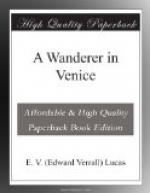Paved with the image of the
sky ... the hoar
And aery Alps towards the
North appeared
Through mist, an heaven-sustaining
bulwark reared
Between the East and West;
and half the sky
Was roofed with clouds of
rich emblazonry
Dark purple at the zenith,
which still grew
Down the steep West into a
wondrous hue
Brighter than burning gold,
even to the rent
Where the swift sun yet paused
in his descent
Among the many-folded hills:
they were
Those famous Euganean hills,
which bear,
As seen from Lido thro’
the harbour piles,
The likeness of a clump of
peaked isles—
And then—as if
the Earth and Sea had been
Dissolved into one lake of
fire, were seen
Those mountains towering as
from waves of flame
Around the vaporous sun, from
which there came
The inmost purple spirit of
light, and made
Their very peaks transparent.
Browning never tired, says Mrs. Bronson, of this evening view from the Lido, and always held that these lines by Shelley were the best description of it.
The poem goes on to describe a visit to the madhouse of S. Clemente and the reflections that arose from it. Towards the close Shelley says:—
If I had been an unconnected
man
I, from this moment, should
have formed some plan
Never to leave sweet Venice,—for
to me
It was delight to ride by
the lone sea;
And then, the town is silent—one
may write
Or read in gondolas by day
or night,
Having the little brazen lamp
alight,
Unseen, uninterrupted; books
are there.
Pictures, and casts from all
those statues fair
Which were twin-born with
poetry, and all
We seek in towns, with little
to recall
Regrets for the green country.
Later in 1818 Mrs. Shelley joined her daughter in Venice, but it was a tragic visit, for their daughter Clara died almost immediately after they arrived. She is buried on the Lido.
In a letter to Peacock, Shelley thus describes the city: “Venice is a wonderfully fine city. The approach to it over the laguna, with its domes and turrets glittering in a long line over the blue waves, is one of the finest architectural delusions in the world. It seems to have—and literally it has—its foundations in the sea. The silent streets are paved with water, and you hear nothing but the dashing of the oars, and the occasional cries of the gondolieri. I heard nothing at Tasso. The gondolas themselves are things of a most romantic and picturesque appearance; I can only compare them to moths of which a coffin might have been the chrysalis. They are hung with black, and painted black, and carpeted with grey; they curl at the prow and stern, and at the former there is a nondescript beak of shining steel, which glitters at the end of its long black mass.




